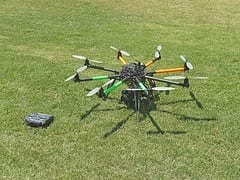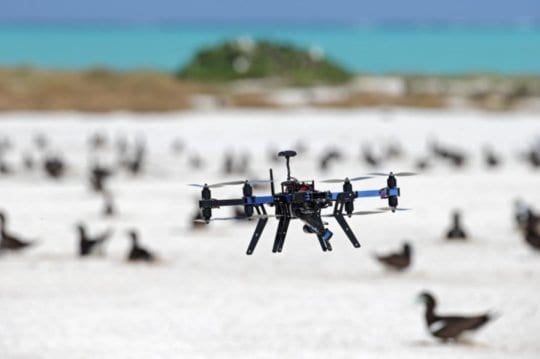
When we think of drones we think of flying killing machines in Pakistan.
But as the US tries to write rules for the technology, people are realizing that very different kinds of drones could change the way we live.
Probably the best illustration of the vivid fears and awesome powers associated with drones was delivered on the floor of the US Senate on March 13, when Senator Rand Paul held his momentous 13-hour filibuster to highlight that “no American should be killed by a drone without first being charged with a crime.”
His oratory marathon compelled US Attorney General Eric Holder to write a letter to Paul assuring him that the US president did not have the authority to kill an American not engaged in combat on American soil with a weaponized drone.
Whether overblown or not, Paul’s concerns reflect the public’s perception of drones as lethal robots hovering high above remote areas in far-away lands under often dubious legal rules. While drones have regularly – and correctly – been portrayed this way in the press, their use as killing machines is only the tip of the iceberg.
In fact, the narrow focus on the military potential of drones tends to underestimate and obfuscate the much broader and much more realistic capabilities of the technology that must be addressed. And unlike Senator Paul’s question for Attorney General Holder, most of the questions raised by the rapid advances in the field of drone technology cannot be answered with a simple yes or no.
Complex technology
Drones can come in different sizes and shapes and with diverse technical features. The smallest drone is the coin-sized Dutch-built Delfly Micro, one of the largest, the Israeli Heron, the size of a Boeing 737.
“Theoretically every plane can be a drone,” explains Missy Cummings, who advises the US Navy on drones and is director of the Humans and Automation Laboratory at the Massachusetts Institute Technology (MIT).
While the US military’s Predator and Reaper are technologically still the most sophisticated drones, a good example of what non-lethal drones can do is a robotic helicopter called K-Max. Basically, K-Max is an air-borne work horse. Since 2011 two K-Max delivery drones in use in Afghanistan have transported more than three million pounds of cargo – all without a pilot.
And that’s just the beginning, says Cummings:
“In the research world we have had helicopter drones that have been able to pick out there own landing sites and were able to land themselves without any help on the ground.”
The technology is there, it just hasn’t been operationalized yet, adds Cummings.
Multiple uses
The most basic function a drone – or an unmanned aircraft system (UAS) as they are also called – can perform is what is known as remote sensing, that is gathering information about objects without physical contact. Unlike a piloted plane or helicopter drones can remain airborne for long hours, hovering over specified objects or tracking targets incessantly while collecting valuable data for real-time or archival use at the same time.
These essential qualities of drones – doing work that is dull, dangerous or dirty – for a fraction of a price that it would cost to hire a pilot and a plane makes UAS so attractive for governmental, commercial and scientific ventures.
The Latest Bing News on:
Game of drones
- Paris Olympics anti-terror procedures faults AC groups for droneson May 9, 2024 at 1:46 am
As the anticipation builds for the upcoming Olympic Games in Paris, concerns regarding security have taken center stage with reports surfacing about ...
- Revolutionary new drone feeds on electricity from power lines and flies foreveron May 8, 2024 at 2:12 pm
Engineers in southern Denmark have taken the drone game a step further, creating a "vampire drone" that can feed off power lines.
- Stellar Blade: Best Drone Upgrades To Unlock ASAPon May 8, 2024 at 12:10 am
Eve's drone in Stellar Blade has a variety of functions that can make a big difference in the game. These upgrades, however, should be prioritized.
- Fire and hide: Ukraine's artillery pinned down by Russian droneson May 7, 2024 at 8:56 am
Rumbling out of its forest hideout, the hulking German-supplied howitzer has only a few minutes to fire before slipping back under cover to evade Russian surveillance in the skies above. Across the ...
- Armies need their own drone air force flown by specialist soldiers, study sayson May 4, 2024 at 2:00 am
The air war over Ukraine has become a cat-and-mouse game where drones must constantly evolve to survive.
- Crimean Bridge is doomed – and game-changing Sea Baby drones are key to battle plan, warns top Ukrainian spy ‘Hunter’on May 3, 2024 at 10:51 pm
UKRAINE has a fresh warning for Vladimir Putin – his beloved, £3billion Crimean Bridge “is doomed”. Ukraine’s security service, the SBU, told The Sun that its army of ...
- ‘We call it the valley of death’: inside Britain’s battle to rearm itselfon May 3, 2024 at 10:05 pm
Described as an Apache gunship that fits in the back of your car, the British-made Hydra drone has the potential to be a game-changer on the battlefield ...
- Should It Be Illegal To Fly an RC Plane Within 3 Miles of a Sports Game?on April 30, 2024 at 11:35 am
The FAA imposes notoriously wide flight restrictions around stadiums. The consumer drone industry wants to change that.
- Tech vs. Pests: How Drones Are Changing the Game in Pest Managementon April 29, 2024 at 7:01 am
A decades-long war remains unresolvedNot easy with conventional methods due to the high rate of reproductionDrones can quickly identify problem areasDevelopment is underway for attack drones that ...
- Stellar Blade: How To Unlock Drone Hacking Toolon April 26, 2024 at 10:09 pm
Players will need the Drone Hacking Tool to unlock High-Security Sealed Chests in Stellar Blade. Here's how to get it.
The Latest Google Headlines on:
Game of drones
[google_news title=”” keyword=”Game of drones” num_posts=”10″ blurb_length=”0″ show_thumb=”left”] [/vc_column_text]The Latest Bing News on:
Drone uses
- Drones and AI are rewriting the rulebook on naval warfare — with uncertain consequenceson May 9, 2024 at 5:00 am
Named after their leader within Ukraine's defence intelligence agency — a man who goes by the nom de guerre Call Sign 13 — this unit of maritime drone operators has destroyed or damaged more than half ...
- Houthis may use undersea drones to attack 'Israeli ships'on May 9, 2024 at 4:36 am
The Yemeni Forces are planning to attack ships bound to Israeli Ports in the Red and Arabian Sea with Underwater Unmanned Vehicles(UUV). A Maryland-based think tank has warned that Houthis are ...
- Ukrainian military demonstrate drone effectiveness at frontline — video, photoson May 9, 2024 at 3:45 am
A video featuring the operations of the 37th Separate Mechanized Brigade's UAV strike company has emerged, it showcases their utilization of diverse munitions to efficiently neutralize adversaries, as ...
- Dazzling drone display flies straight into the record bookson May 8, 2024 at 11:00 pm
A San Francisco-based company called UVify has set a new world record for the most drones used in an aerial display.
- Mandan Police receive $35,000 for new droneson May 8, 2024 at 9:20 pm
MANDAN, N.D. (KFYR) - The Mandan Police Department will be the first agency in the state to get specialized drones. Marathon Petroleum awarded $35,000 to the department for the new technology. Mandan ...
- Revolutionary new drone feeds on electricity from power lines and flies foreveron May 8, 2024 at 2:12 pm
Engineers in southern Denmark have taken the drone game a step further, creating a "vampire drone" that can feed off power lines.
- Israeli developer of VR drone system used by IDF in Hamas war raises $40mon May 8, 2024 at 12:23 pm
Tel Aviv startup Xtend, a developer of a human-guided AI drone and robots operating system that was tested and deployed by the Israeli army in a dense urban battlefield during the ongoing war with the ...
- US Drone Warfare Faces Questions of Legitimacy, Study of Military Chaplains Showson May 8, 2024 at 10:49 am
The American public tends not to question military action it perceives as rightful, and U.S. policymakers often reference the legitimacy of U.S. drone strikes.
- Drone used to restore power to southeast Kansas townon May 8, 2024 at 10:24 am
A Sedgwick County jury has convicted a 45-year-old man of sex acts against five children. In all, the jury found David Mendoza guilty of 25 counts. Wyandotte County confirmed it's talking to the fuel ...
- Drone Used To Find Stranded Boat In Peconic Bayon May 8, 2024 at 6:00 am
Five people were rescued after police used a drone to find a 17-foot boat stranded off the coast of Long Island. The incident occurred around 10 p.m., Tuesday, May 7, in Peconic Bay in Riverhead.
The Latest Google Headlines on:
Drone uses
[google_news title=”” keyword=”drone uses” num_posts=”10″ blurb_length=”0″ show_thumb=”left”]










